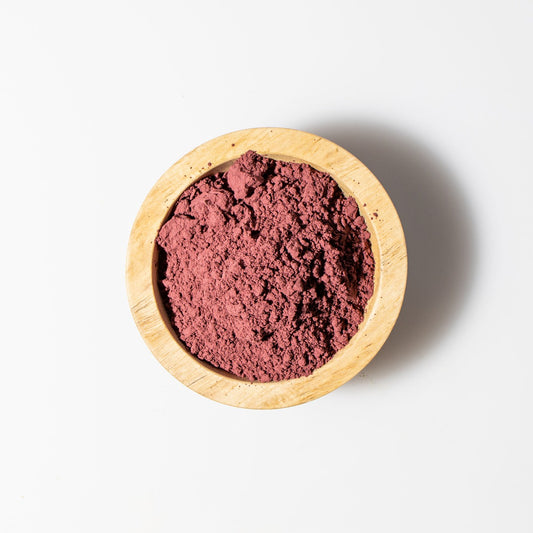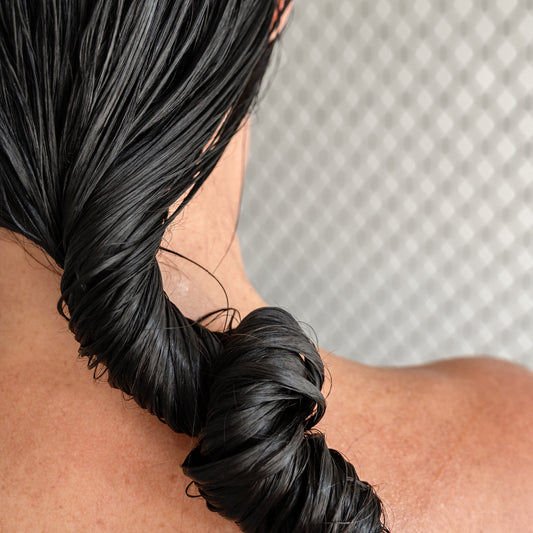The hibiscus plant, or Hibiscus sabdariffa, may be best known for its bright, beautiful blossoms, which naturally transport the imagination to a warm, tropical paradise. These bold, delicate flowers have commonly been enjoyed for their decorative beauty and used in sacred devotional ceremonies, but their generous offerings don't end there. The hibiscus flower also carries a soothing, purifying, and healing energy that makes it a precious and powerful herbal ally.
In this article:
Buy Hibiscus Now
Characteristics of the Hibiscus Plant
Also commonly known as “roselle” or “red sorrel,” the hibiscus plant is a part of the Malvaceae family, which also includes hollyhock, okra, and cotton. While there are over 300 species of hibiscus, this particular type, Hibiscus sabdariffa, holds a special place among Ayurvedic herbs.
Hibiscus is an annual that thrives in warm, tropical, or subtropical climates, with plenty of sunlight, heat, and humidity. This branching shrub can grow up to an impressive nine feet and produces striking red flowers, which is the part Banyan harvests. 1
Hibiscus Benefits and Uses
In addition to its aesthetic beauty and traditional role in sacred ceremonies, hibiscus offers a long list of physical benefits for many different systems and tissues in the body:2,3,4
- Promotes healthy hair growth
- Supports healthy skin and a clear complexion
- Removes excess heat from the body
- Supports proper function of the kidneys
- Supports the female reproductive system
- Helps maintain healthy weight
- Supports the health of the liver
- Promotes the healthy function of the heart
- Supports healthy circulation
- Promotes healthy blood pressure levels already in the normal range
- Helps maintain healthy cholesterol levels already within the normal range

Hibiscus and Ayurveda: Traditional Uses
According to
, hibiscus has a sweet and astringent taste, or
, and a cooling
, or energetic effect on the body. These qualities make it ideal for
and
but aggravating for
if used in excess. 5
If you do not know your
, you can find out by taking our free dosha quiz.
In traditional Indian culture, hibiscus flowers are associated with the elephant-headed god Ganesha, who is known as the “destroyer of obstacles” and said to grant the realization of all of our life goals. 6
The energy of Ganesha is said to reside in the first and second
of the body, which are related to the kidneys and reproductive organs—both areas where hibiscus' benefits shine.
Because of its affinity for the lower region of the body, hibiscus has often been used to support the female reproductive organs and menstruation, promote healthy urination, and support the health and function of the kidneys. 7 This, however, is only the beginning of hibiscus's many traditional uses.
Ayurveda also uses the bright, healing qualities of hibiscus flowers to support the heart and circulatory system, recognizing their ability to purify the blood, promote a clear, glowing complexion, and uplift the heart (both physically and spiritually). 8
How to Take Hibiscus
Thanks to its deliciously satisfying taste, hibiscus is an easy and enjoyable supplement to incorporate into your herbal regime. It can be used in a variety of ways, both internally and externally, depending on your intention and preference.
Internal Uses:
Because taste plays such an important role in the digestive process and signals the body to initiate its own metabolic function, Ayurveda traditionally recommends tasting herbs, and ingesting them in a powdered form when possible.
For a simple and traditional method of use, Banyan Botanicals' hibiscus powder can be mixed with warm water, honey, or ghee, each of which acts as an
or carrier substance to drive the healing benefits of the herb deep into the tissues of the body. Our recommended dose is ¼–½ teaspoon, taken once or twice daily.
Alternatively, you can take hibiscus in an herbal formula.
-
Mood Support combines hibiscus with other highly researched mood-enhancing herbs, including saffron, rose, and beet, to soothe anxiousness, enhance mental outlook, and promote emotional well-being.
-
Elevated Adaptogens combines hibiscus with several other adaptogenic herbs and superfoods for whole-body support. This formula provides the heart-healthy benefits of hibiscus while simultaneously rejuvenating and fortifying every other tissue layer in the body.
Infused with a slightly sweet and sour taste, somewhat similar to cranberries or rosehips, hibiscus is often enjoyed as a refreshing summertime hibiscus tea, either as a hot or cold herbal infusion.
-
For a hot tea: simply add ½ teaspoon of hibiscus to a cup of hot water, steep for 5–10 minutes, then strain.
-
For a cool and refreshing sun tea: add 1–2 tablespoons of hibiscus powder to a quart of cold water and let it sit in the sun for 2–6 hours. When the water is infused to your liking with the hibiscus' beautiful ruby color, strain any excess powder and serve with a sprig of mint.
Or for a slightly more complex and decadent treat, try making a Hibiscus Tulsi Cooler.
Hibiscus is also a key ingredient in Joyful Heart, an uplifting tea blend that promotes harmony and imparts a sense of peace.
External Uses:
Hibiscus powder is very popular in Ayurvedic skin care. It can be used externally to support healthy, lustrous hair and radiant, glowing skin—enhancing natural beauty from the outside-in as well as the inside-out.
For a pitta-balancing, beautifying hair mask, simply mix the powder with water until you have a thick paste. Then apply carefully to your hair and scalp, allow it to dry, and rinse off in the shower.
You can also use our nourishing Healthy Hair Oil, which combines the benefits of hibiscus with bhringaraj, brahmi/gotu kola, amalaki, and rose.
To promote clear, healthy, radiant skin, you can make your own face mask with hibiscus powder and water, adding chickpea flour if desired, for a traditional DIY
beauty treatment.
Modern Research on Hibiscus
In recent years, various scientific studies have played a role in exploring and confirming the health benefits of hibiscus. A majority of these studies have focused specifically on hibiscus' effect on cardiovascular health, addressing such areas as cholesterol levels, hypertension, and blood pressure.
The following links summarize some of these findings:
- “Therapeutic Potential of Hibiscus Sabdariffa: A Review of the Scientific Evidence.” PubMed Abstract. Jan 2014. 9
- “Hibiscus, Hawthorn, and the Heart: Modern Research Supports the Use of Traditional Plants.” ND Natural Medicine Journal. Jul 2011. 10
- “Hibiscus sabdariffa… A Comprehensive Review of Animal and Human Studies.” PubMed Abstract. Mar 2013. 11
- “A Review of the Effectiveness of Hibiscus…” ScienceDirect. Apr 2021. 12
Is Hibiscus Safe?
When used in moderation, hibiscus is regarded as a safe, beneficial, and delicious way to support the health of your body, especially for those with a pitta or kapha constitution.
Along with the many benefits we have already discussed, it is thought to be rich in antioxidants and vitamin C, making it potentially useful for strengthening a healthy immune system and supporting the body's overall well-being. 13
Contraindications
For those with a primarily vata constitution, hibiscus can be used occasionally, but should be avoided in large amounts. Due to its astringent and cooling properties, it can be aggravating to vata.
It should also be avoided in the case of severe chills and by those experiencing low blood sugar levels. 14,15
Always consult your healthcare practitioner if you have questions related to your particular condition, or if you are taking prescription medications. Additionally, women who are pregnant or breastfeeding should always consult with a doctor or healthcare professional before using hibiscus or any other herb.
The Growing and Harvesting of Banyan's Hibiscus
Banyan's hibiscus is grown in partnership with Fair for Life (FFL) certified farms in the state of Uttar Pradesh in Rath, India, where the flowers are harvested from October to March. The harvest is sun-dried for two days to lower the moisture, then moved into the shade.
When it has finished drying, it is packed in bags and transported to our warehouse in Albuquerque, New Mexico, where it is cleaned, graded, and sorted on tables by hand. Then it is processed and ready to be added into formulas, teas, or ground into hibiscus powder.
The hibiscus powder goes through an extra steam sterilization process that uses cryogenic milling in negative temperatures. This helps the herb maintain its color, fragrance, texture, quality, and efficacy.
Sustainability
Although global demand for hibiscus and other herbal teas has risen substantially, hibiscus is not presently at risk of becoming endangered.
As a part of a larger conversation regarding the sustainability of Ayurvedic herbs, it is important to understand where and how plants are grown and harvested.
We ensure sustainability by sourcing the botanicals used in our products from privately owned farms where each plant has been cultivated or harvested from legal wild-craft sourcing. Our herbs and ingredient-producing plants are harvested at optimal times, using environmentally sustainable practices sensitive to the long-term health of the plants.











